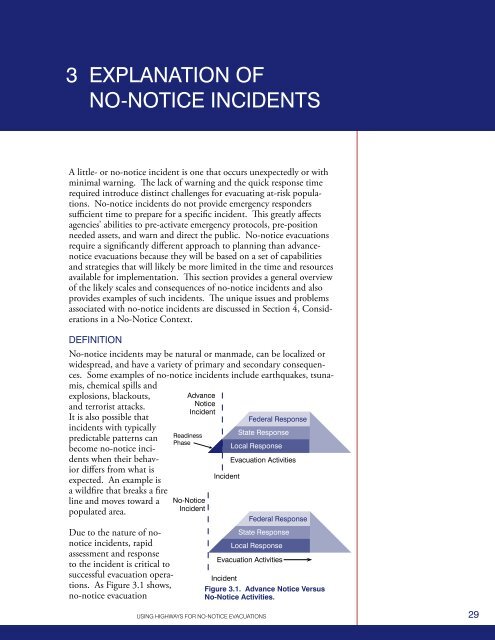using highways for no-notice evacuations - FHWA Operations - U.S. ...
using highways for no-notice evacuations - FHWA Operations - U.S. ...
using highways for no-notice evacuations - FHWA Operations - U.S. ...
Create successful ePaper yourself
Turn your PDF publications into a flip-book with our unique Google optimized e-Paper software.
3 Explanation ofNo-Notice IncidentsA little- or <strong>no</strong>-<strong>no</strong>tice incident is one that occurs unexpectedly or withminimal warning. The lack of warning and the quick response timerequired introduce distinct challenges <strong>for</strong> evacuating at-risk populations.No-<strong>no</strong>tice incidents do <strong>no</strong>t provide emergency responderssufficient time to prepare <strong>for</strong> a specific incident. This greatly affectsagencies’ abilities to pre-activate emergency protocols, pre-positionneeded assets, and warn and direct the public. No-<strong>no</strong>tice <strong>evacuations</strong>require a significantly different approach to planning than advance<strong>no</strong>tice<strong>evacuations</strong> because they will be based on a set of capabilitiesand strategies that will likely be more limited in the time and resourcesavailable <strong>for</strong> implementation. This section provides a general overviewof the likely scales and consequences of <strong>no</strong>-<strong>no</strong>tice incidents and alsoprovides examples of such incidents. The unique issues and problemsassociated with <strong>no</strong>-<strong>no</strong>tice incidents are discussed in Section 4, Considerationsin a No-Notice Context.DEFINITIONNo-<strong>no</strong>tice incidents may be natural or manmade, can be localized orwidespread, and have a variety of primary and secondary consequences.Some examples of <strong>no</strong>-<strong>no</strong>tice incidents include earthquakes, tsunamis,chemical spills andexplosions, blackouts,and terrorist attacks.It is also possible thatincidents with typicallypredictable patterns canbecome <strong>no</strong>-<strong>no</strong>tice incidentswhen their behaviordiffers from what isexpected. An example isa wildfire that breaks a fireline and moves toward apopulated area.Due to the nature of <strong>no</strong><strong>no</strong>ticeincidents, rapidassessment and responseto the incident is critical tosuccessful evacuation operations.As Figure 3.1 shows,<strong>no</strong>-<strong>no</strong>tice evacuationReadinessPhaseAdvanceNoticeIncidentNo-NoticeIncidentIncidentFederal ResponseState ResponseLocal ResponseEvacuation ActivitiesFederal ResponseState ResponseLocal ResponseEvacuation ActivitiesIncidentFigure 3.1. Advance Notice VersusNo-Notice Activities.USING HIGHWAYS FOR NO-NOTICE EVACUATIONS29
















